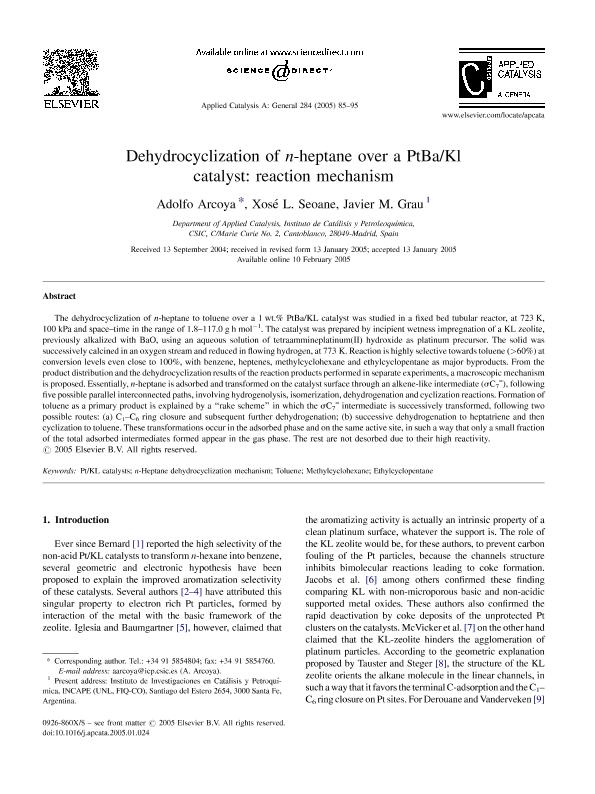Mostrar el registro sencillo del ítem
dc.contributor.author
Arcoya, Adolfo
dc.contributor.author
Seoane, Xosé L.
dc.contributor.author
Grau, Javier Mario

dc.date.available
2018-08-14T15:18:21Z
dc.date.issued
2005-04
dc.identifier.citation
Arcoya, Adolfo; Seoane, Xosé L.; Grau, Javier Mario; Dehydrocyclization of n-heptane over a PtBa/Kl catalyst: Reaction mechanism; Elsevier Science; Applied Catalysis A: General; 284; 1-2; 4-2005; 85-95
dc.identifier.issn
0926-860X
dc.identifier.uri
http://hdl.handle.net/11336/55357
dc.description.abstract
The dehydrocyclization of n-heptane to toluene over a 1 wt.% PtBa/KL catalyst was studied in a fixed bed tubular reactor, at 723 K, 100 kPa and space-time in the range of 1.8-117.0 g h mol-1. The catalyst was prepared by incipient wetness impregnation of a KL zeolite, previously alkalized with BaO, using an aqueous solution of tetraammineplatinum(II) hydroxide as platinum precursor. The solid was successively calcined in an oxygen stream and reduced in flowing hydrogen, at 773 K. Reaction is highly selective towards toluene (>60%) at conversion levels even close to 100%, with benzene, heptenes, methylcyclohexane and ethylcyclopentane as major byproducts. From the product distribution and the dehydrocyclization results of the reaction products performed in separate experiments, a macroscopic mechanism is proposed. Essentially, n-heptane is adsorbed and transformed on the catalyst surface through an alkene-like intermediate (σC7=), following five possible parallel interconnected paths, involving hydrogenolysis, isomerization, dehydrogenation and cyclization reactions. Formation of toluene as a primary product is explained by a "rake scheme" in which the σC7= intermediate is successively transformed, following two possible routes: (a) C1-C6 ring closure and subsequent further dehydrogenation; (b) successive dehydrogenation to heptatriene and then cyclization to toluene. These transformations occur in the adsorbed phase and on the same active site, in such a way that only a small fraction of the total adsorbed intermediates formed appear in the gas phase. The rest are not desorbed due to their high reactivity.
dc.format
application/pdf
dc.language.iso
eng
dc.publisher
Elsevier Science

dc.rights
info:eu-repo/semantics/openAccess
dc.rights.uri
https://creativecommons.org/licenses/by-nc-nd/2.5/ar/
dc.subject
Ethylcyclopentane
dc.subject
Methylcyclohexane
dc.subject
N-Heptane Dehydrocyclization Mechanism
dc.subject
Pt/Kl Catalysts
dc.subject
Toluene
dc.subject.classification
Otras Ingeniería Química

dc.subject.classification
Ingeniería Química

dc.subject.classification
INGENIERÍAS Y TECNOLOGÍAS

dc.title
Dehydrocyclization of n-heptane over a PtBa/Kl catalyst: Reaction mechanism
dc.type
info:eu-repo/semantics/article
dc.type
info:ar-repo/semantics/artículo
dc.type
info:eu-repo/semantics/publishedVersion
dc.date.updated
2018-08-13T18:13:47Z
dc.journal.volume
284
dc.journal.number
1-2
dc.journal.pagination
85-95
dc.journal.pais
Países Bajos

dc.journal.ciudad
Amsterdam
dc.description.fil
Fil: Arcoya, Adolfo. Consejo Superior de Investigaciones Científicas. Instituto de Catálisis y Petroleoquímica; España
dc.description.fil
Fil: Seoane, Xosé L.. Consejo Superior de Investigaciones Científicas. Instituto de Catálisis y Petroleoquímica; España
dc.description.fil
Fil: Grau, Javier Mario. Consejo Superior de Investigaciones Científicas. Instituto de Catálisis y Petroleoquímica; España. Consejo Nacional de Investigaciones Científicas y Técnicas. Centro Científico Tecnológico Conicet - Santa Fe. Instituto de Investigaciones en Catálisis y Petroquímica "Ing. José Miguel Parera". Universidad Nacional del Litoral. Instituto de Investigaciones en Catálisis y Petroquímica "Ing. José Miguel Parera"; Argentina
dc.journal.title
Applied Catalysis A: General

dc.relation.alternativeid
info:eu-repo/semantics/altIdentifier/doi/http://dx.doi.org/10.1016/j.apcata.2005.01.024
dc.relation.alternativeid
info:eu-repo/semantics/altIdentifier/url/https://www.sciencedirect.com/science/article/pii/S0926860X0500030X
Archivos asociados
